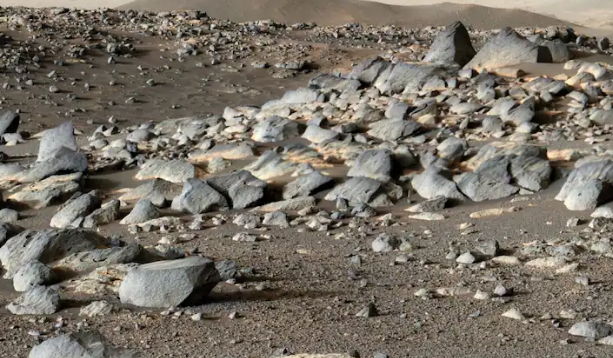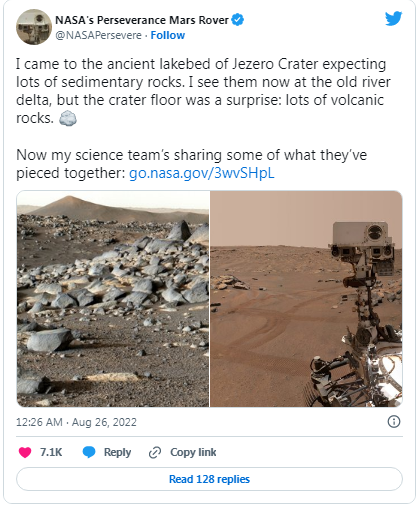by Rida Fatima

(Fig 1: Instead of just sedimentary rocks, the Perseverance rover from NASA discovered something in the early stages of life in the Jezero Crater on Mars. Jezero Crater on Mars was photographed by NASA’s Perseverance rover.)
Since red rocks and craters can be seen in every Mars image that has been seen by humanity so far, Mars is thought of as a red planet. Scientists did not expect to see anything otherwise when NASA’s Perseverance rover landed in Mars’ Jezero Crater. However, what the rover discovered on the ground was unexpected. As we have seen in the past, Jazero Crater was chosen as the perfect location for the rover to land, as this part of Mars has a very rich river system, magnetic field, air, and liquid water. Two famous planetary researchers in the fields of earth sciences, planetary sciences, and atmospheric sciences are known as Roger Wiens and Briony Horgan, and they have published something very new in the famous journals. According to information released by Purdue University, where these researchers work, the rover was going to witness sedimentary rocks on the bottom side of the lake, but instead, it witnessed something different and unexpected and discovered many of these rocks to be volcanic in origin. According to the university, these rocks were discovered to contain “huge grains of olivine, the muddier, less-gemlike variant of period that colors so many of Hawaii’s beaches rich green” (ABP, 2022).

(Fig 2: A tweet by NASA’s official about the Jazero Crater. Picture Credits: Twitter and NASA.)
They began to notice that the layered igneous rocks we were witnessing did not resemble the igneous rocks found on Earth today. Instead, they resemble the igneous rocks that formed when the Earth first formed, according to Wiens. In order to analyze samples and identify the kind and provenance of the rocks, the SuperCam on Perseverance was designed and built under Wiens’ direction. Horgan, on the other hand, assisted in deciding on Jezero Crater as the rover’s landing spot. The rocks and lava that the rover on Mars is examining are almost 4 billion years old, according to the experts. The fact that our planet has active tectonic plates, in addition to the weathering impacts of wind, water, and life over billions of years, means that while such ancient rocks have been discovered, they are severely weather-beaten. But on Mars, these rocks are pure, making it far simpler to investigate them, the university claimed (ABP, 2022).
The Jezero Crater Surprise
During the spring of 2021, the Perseverance rover from NASA started studying the rocks in Jezero Crater on Mars. When the rover communicated what they had discovered, scientists were taken aback. Since the location once hosted a lake, sedimentary rock that formed when sand and mud settled in the wet environment was expected to be there. Instead, the rover found that the floor was composed of two different types of igneous rock, one of which was generated by magma deep beneath and the other by volcanic activity on the surface, according to NASA. Because the crystals in igneous rocks preserve a wealth of information regarding the precise moment of their formation, they are regarded as excellent timekeepers.
According to a NASA blog post by Ken Farley of Caltech, the project scientist for Perseverance and the author of the aforementioned Science publication, “The igneous rocks we obtained will tell us approximately when the lake was existing in Jezero. We are aware that it predates the formation of the igneous crater floor rocks.” He said that this would answer several important concerns, such as when Mars’ environment was suitable for lakes and rivers and when it reverted to the extremely chilly and dry conditions that exist today. The hunt for life is one of Perseverance’s primary professed objectives. However, igneous rock isn’t the best material for preserving any potential traces of prehistoric microscopic life that the rover may find, according to NASA, because of the manner it was generated. On the other hand, sedimentary rock frequently originates in wet settings that are favorable for life, making it better at preserving early indications of life. Sedimentary rock’s age might be difficult to ascertain, especially if it includes fragments that were produced at several points before the sediment was deposited (ABP, 2022).
According to NASA, this is why scientists found the sediment-rich river delta that the rover has been exploring since April 2022 to be particularly “tantalising.” We observed these rocks from orbit and said, “Oh, they have gorgeous layers! We therefore assumed that they were sedimentary rocks. We didn’t realise that these are not sedimentary rocks until we were up close and examined them at the millimetre scale. Actually, these are old lava. We had a major breakthrough when we discovered it on the ground, and it amply demonstrated the need for this kind of exploration”, according to Horgan, who was quoted by Purdue.
Scientists have high hopes for the sedimentary rocks that Perseverance is currently analysing after uncovering the potential for habitable conditions in Jezero Crater’s old lava flows, which are currently thought to be uninhabitable (TECH, 2022).
The anticipation for “further greater results about organics and old, livable ecosystems” is expressed by Horgan. “According to my observations, it is really laying the groundwork that the Red Planet is this much of an aqueous, livable planet, and by getting all the samples back, it will lead us to understand even better the chemistry of ancient microbial life that is existing on the Red Planet,” the researcher says. Furthermore, NASA is still collecting major samples of the sedimentary rocks, which will be returned to Earth by the Mars Sample Return campaign, and further analysis will be done in well-equipped labs.
References
- There Is Green Sand Too On Red Planet Mars, NASA Perseverance Rover Discovers. (2022, August). Retrieved December, 2022, from https://news.abplive.com/science/nasa-perseverance-rover-discovers-green-sand-on-red-planet-mars-1550117
- NASA’s Perseverance Rover found green sand on Mars. (2022, September). HT Tech. Retrieved December 2022, from https://tech.hindustantimes.com/tech/news/nasas-perseverance-rover-found-green-sand-on-mars-71662561528925.html
